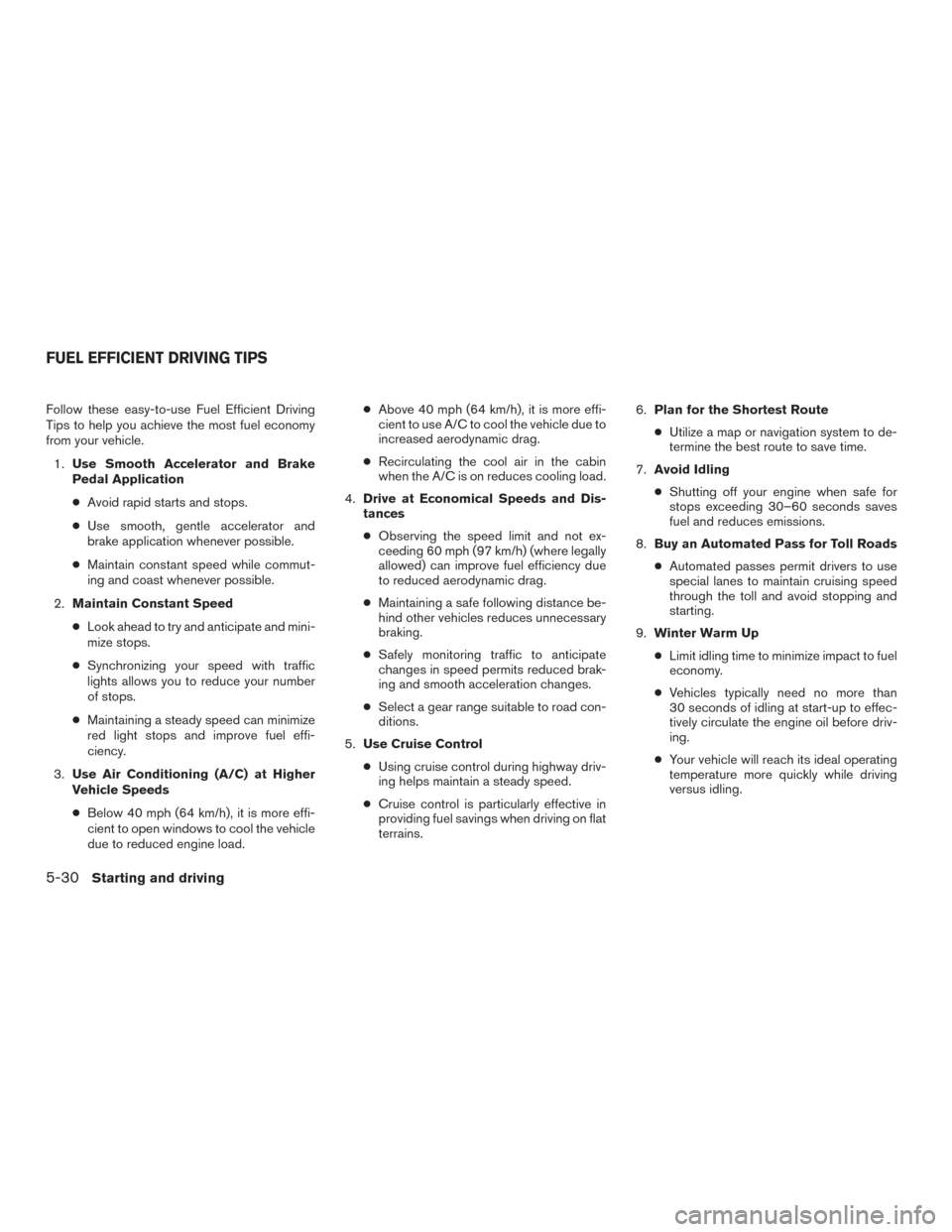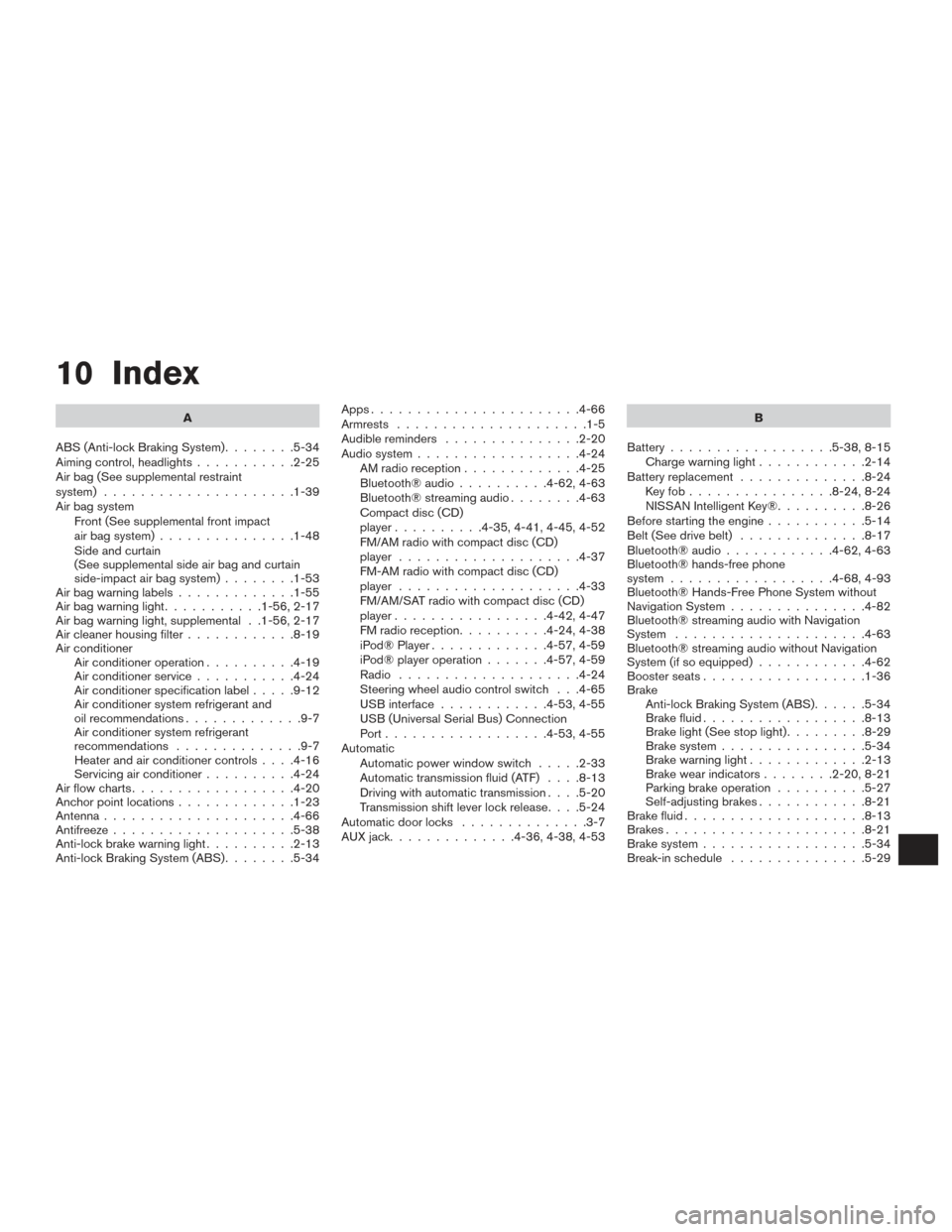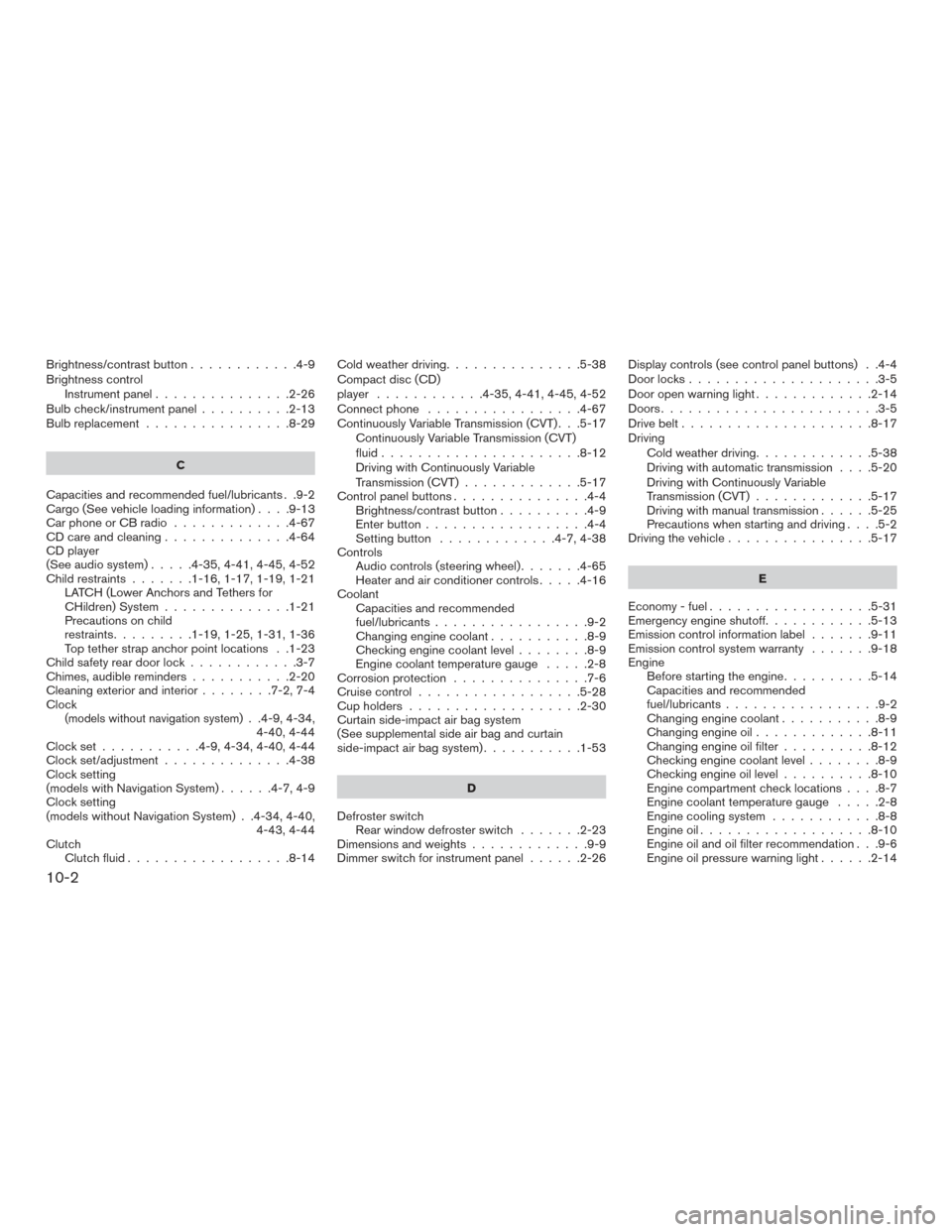2016 NISSAN VERSA SEDAN navigation system
[x] Cancel search: navigation systemPage 279 of 386

Follow these easy-to-use Fuel Efficient Driving
Tips to help you achieve the most fuel economy
from your vehicle.1. Use Smooth Accelerator and Brake
Pedal Application
● Avoid rapid starts and stops.
● Use smooth, gentle accelerator and
brake application whenever possible.
● Maintain constant speed while commut-
ing and coast whenever possible.
2. Maintain Constant Speed
● Look ahead to try and anticipate and mini-
mize stops.
● Synchronizing your speed with traffic
lights allows you to reduce your number
of stops.
● Maintaining a steady speed can minimize
red light stops and improve fuel effi-
ciency.
3. Use Air Conditioning (A/C) at Higher
Vehicle Speeds
● Below 40 mph (64 km/h), it is more effi-
cient to open windows to cool the vehicle
due to reduced engine load. ●
Above 40 mph (64 km/h), it is more effi-
cient to use A/C to cool the vehicle due to
increased aerodynamic drag.
● Recirculating the cool air in the cabin
when the A/C is on reduces cooling load.
4. Drive at Economical Speeds and Dis-
tances
● Observing the speed limit and not ex-
ceeding 60 mph (97 km/h) (where legally
allowed) can improve fuel efficiency due
to reduced aerodynamic drag.
● Maintaining a safe following distance be-
hind other vehicles reduces unnecessary
braking.
● Safely monitoring traffic to anticipate
changes in speed permits reduced brak-
ing and smooth acceleration changes.
● Select a gear range suitable to road con-
ditions.
5. Use Cruise Control
● Using cruise control during highway driv-
ing helps maintain a steady speed.
● Cruise control is particularly effective in
providing fuel savings when driving on flat
terrains. 6.
Plan for the Shortest Route
● Utilize a map or navigation system to de-
termine the best route to save time.
7. Avoid Idling
● Shutting off your engine when safe for
stops exceeding 30–60 seconds saves
fuel and reduces emissions.
8. Buy an Automated Pass for Toll Roads
● Automated passes permit drivers to use
special lanes to maintain cruising speed
through the toll and avoid stopping and
starting.
9. Winter Warm Up
● Limit idling time to minimize impact to fuel
economy.
● Vehicles typically need no more than
30 seconds of idling at start-up to effec-
tively circulate the engine oil before driv-
ing.
● Your vehicle will reach its ideal operating
temperature more quickly while driving
versus idling.
FUEL EFFICIENT DRIVING TIPS
5-30Starting and driving
Page 378 of 386

10 Index
A
ABS (Anti-lock Braking System) ........5-34
Aiming control, headlights ...........2-25
Air bag (See supplemental restraint
system) .....................1-39
Air bag system Front (See supplemental front impact
air bag system) ...............1-48
Side and curtain
(See supplemental side air bag and curtain
side-impact air bag system) ........1-53
Airbagwarninglabels.............1-55
Airbagwarninglight...........1-56,2-17
Air bag warning light, supplemental . .1-56, 2-17
Air cleaner housing filter ............8-19
Air conditioner Air conditioner operation ..........4-19
Air conditioner service ...........4-24
Air conditioner specification label .....9-12
Air conditioner system refrigerant and
oil recommendations .............9-7
Air conditioner system refrigerant
recommendations ..............9-7
Heater and air conditioner controls ....4-16
Servicing air conditioner ..........4-24
Airflowcharts..................4-20
Anchor point locations .............1-23
Antenna .....................4-66
Antifreeze ....................5-38
Anti-lock brake warning light ..........2-13
Anti-lock Braking System (ABS) ........5-34Apps
.......................4-66
Armrests .....................1-5
Audible reminders ...............2-20
Audio system ..................4-24
AMradioreception.............4-25
Bluetooth®audio..........4-62,4-63
Bluetooth® streaming audio ........4-63
Compact disc (CD)
player..........4-35,4-41,4-45,4-52
FM/AM radio with compact disc (CD)
player ....................4-37
FM-AM radio with compact disc (CD)
player ....................4-33
FM/AM/SAT radio with compact disc (CD)
player.................4-42,4-47
FMradioreception..........4-24,4-38
iPod® Player .............4-57,4-59
iPod® player operation .......4-57,4-59
Radio ....................4-24
Steering wheel audio control switch . . .4-65
USB interface ............4-53,4-55
USB (Universal Serial Bus) Connection
Port..................4-53,4-55
Automatic Automatic power window switch .....2-33
Automatic transmission fluid (ATF) ....8-13
Driving with automatic transmission ....5-20
Transmission shift lever lock release ....5-24
Automatic door locks ..............3-7
AUXjack..............4-36,4-38,4-53 B
Battery ..................5-38, 8-15
Charge warning light ............2-14
Battery replacement ..............8-24
Keyfob................8-24,8-24
NISSAN Intelligent Key® ..........8-26
Before starting the engine ...........5-14
Belt (See drive belt) ..............8-17
Bluetooth® audio ............4-62,4-63
Bluetooth® hands-free phone
system..................4-68,4-93
Bluetooth® Hands-Free Phone System without
Navigation System ...............4-82
Bluetooth® streaming audio with Navigation
System .....................4-63
Bluetooth® streaming audio without Navigation
System (if so equipped) ............4-62
Boosterseats..................1-36
Brake Anti-lock Braking System (ABS) ......5-34
Brake fluid ..................8-13
Brakelight(Seestoplight).........8-29
Brake system ................5-34
Brakewarninglight.............2-13
Brakewearindicators........2-20,8-21
Parking brake operation ..........5-27
Self-adjusting brakes ............8-21
Brake fluid ....................8-13
Brakes ......................8-21
Brake system .................. 5
-34
Break-inschedule ...............5-29
Page 379 of 386

Brightness/contrastbutton............4-9
Brightness controlInstrument panel ...............2-26
Bulb check/instrument panel ..........2-13
Bulb replacement ................8-29
C
Capacities and recommended fuel/lubricants . .9-2
Cargo(Seevehicleloadinginformation)....9-13
Car phone or CB radio .............4-67
CD care and cleaning ..............4-64
CD player
(See audio system) .....4-35,4-41,4-45,4-52
Child restraints .......1-16,1-17,1-19,1-21
LATCH (Lower Anchors and Tethers for
CHildren) System ..............1-21
Precautions on child
restraints.........1-19,1-25,1-31,1-36
Top tether strap anchor point locations . .1-23
Child safety rear door lock ............3-7
Chimes, audible reminders ...........2-20
Cleaningexteriorandinterior........7-2,7-4
Clock
(models without navigation system). .4-9, 4-34, 4-40, 4-44
Clockset...........4-9,4-34,4-40,4-44
Clock set/adjustment ..............4-38
Clock setting
(models with Navigation System) ......4-7,4-9
Clock setting
(models without Navigation System) . .4-34, 4-40, 4-43, 4-44
Clutch Clutch fluid ..................8-14 Cold weather driving
...............5-38
Compact disc (CD)
player ............4-35,4-41,4-45,4-52
Connect phone .................4-67
Continuously Variable Transmission (CVT) . . .5-17 Continuously Variable Transmission (CVT)
fluid......................8-12
Driving with Continuously Variable
Transmission (CVT) .............5-17
Control panel buttons ...............4-4
Brightness/contrast button ..........4-9
Enterbutton..................4-4
Setting button .............4-7,4-38
Controls Audio controls (steering wheel) .......4-65
Heater and air conditioner controls .....4-16
Coolant Capacities and recommended
fuel/lubricants .................9-2
Changingenginecoolant...........8-9
Checking engine coolant level ........8-9
Engine coolant temperature gauge .....2-8
Corrosion protection ...............7-6
Cruisecontrol..................5-28
Cupholders...................2-30
Curtain side-impact air bag system
(See supplemental side air bag and curtain
side-impact air bag system) ...........1-53
D
Defroster switch Rear window defroster switch .......2-23
Dimensionsandweights.............9-9
Dimmer switch for instrument panel ......2-26Display controls (see control panel buttons) . .4-4
Door locks
.....................3-5
Door open warning light .............2-14
Doors ........................3-5
Drive belt .....................8-17
Driving Cold weather driving .............5-38
Driving with automatic transmission ....5-20
Driving with Continuously Variable
Transmission (CVT) .............5-17
Driving with manual transmission ......5-25
Precautions when starting and driving ....5-2
Driving the vehicle ................5-17
E
Economy-fuel..................5-31
Emergency engine shutoff ............5-13
Emission control information label .......9-11
Emission control system warranty .......9-18
Engine Before starting the engine ..........5-14
Capacities and recommended
fuel/lubricants.................9-2
Changing engine coolant ...........8-9
Changingengineoil.............8-11
Changing engine oil filter ..........8-12
Checking engine coolant level ........8-9
Checking engine oil level ..........8-10
Engine compartment check locations ....8-7
Engine coolant temperature gauge .....2-8
Engine cooling system ............8-8
Engineoil...................8-10
Engine oil and oil filter recommendation . . .9-6
Engine oil pressure warning light ......2-14
10-2